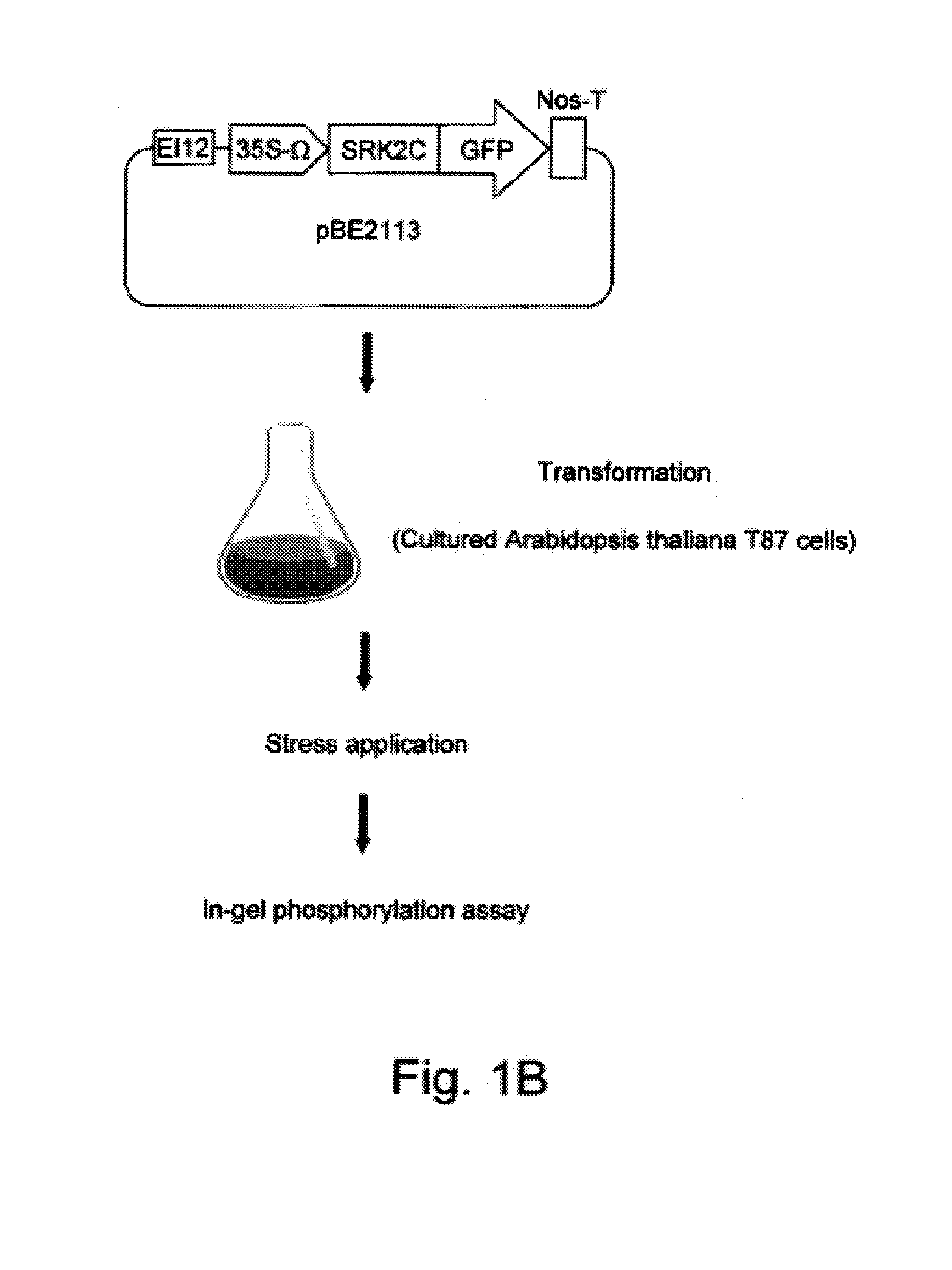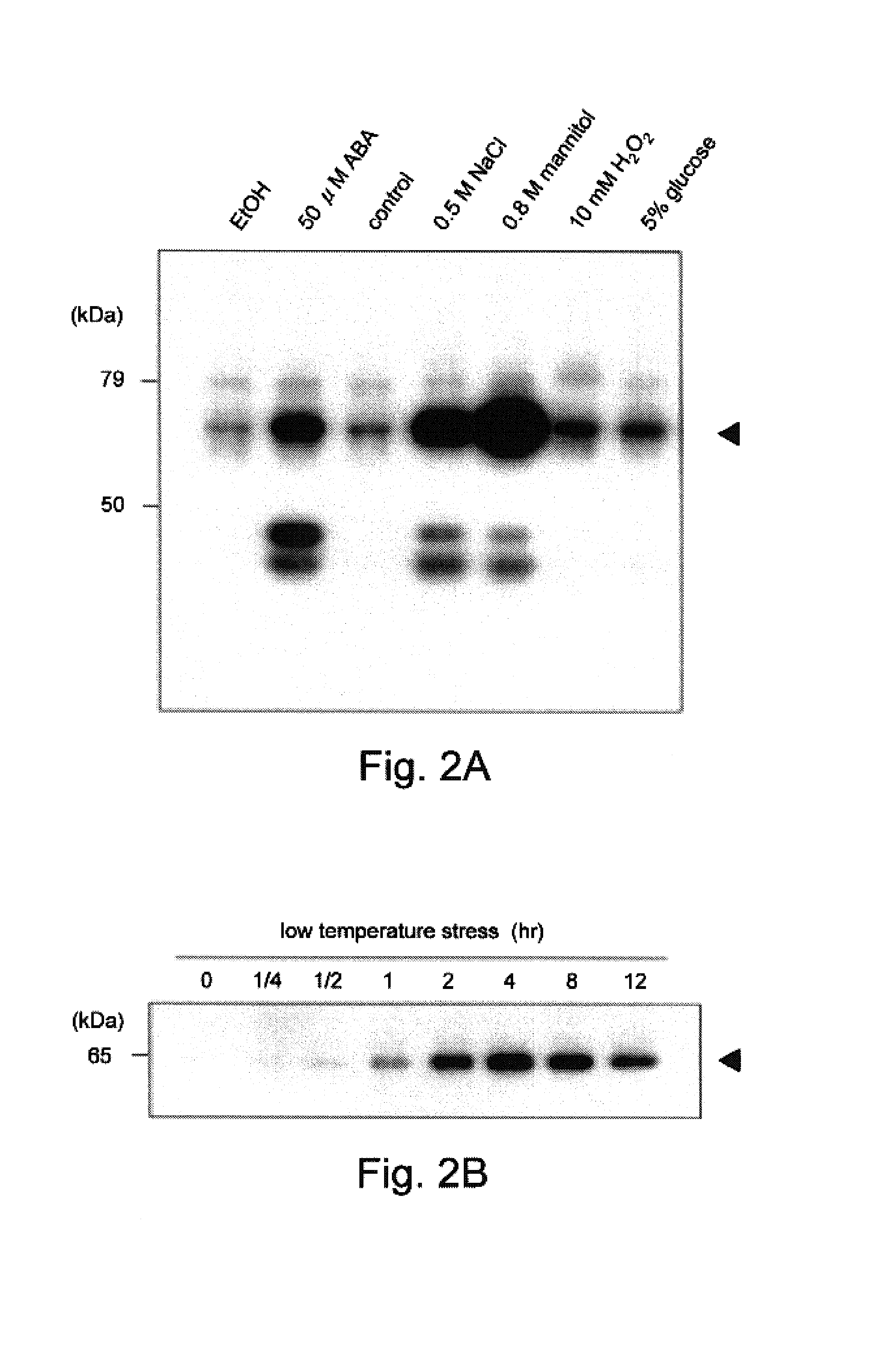Plant having tolerance to environmental stress
a technology of environmental stress and plant, applied in the direction of enzymology, organic chemistry, transferases, etc., can solve the problem that no signal transduction factor that would activate the dreb/cbf transcription factor has been found in the upstream region
- Summary
- Abstract
- Description
- Claims
- Application Information
AI Technical Summary
Benefits of technology
Problems solved by technology
Method used
Image
Examples
example 1
Introduction of SRK2C Gene into Plant
[0097]There are 10 SnRK2 protein kinases (SRK2A to SRK2J) on the Arabidopsis thaliana genome, and they are classified into SnRK2a and SnRK2b subfamilies depending on phylogenetic systems (FIG. 1A). In the present example, full-length cDNA of SRK2C, which is a member of the SnRK2 protein kinase family, is isolated, this SRK2C gene is introduced into a cultured Arabidopsis thaliana cell to obtain a transgenic plant, and stress is applied to this transgenic plant to assay activation of SRK2C.
[0098]Total RNA was extracted from an Arabidopsis thaliana seedling using the Total RNA Extraction Kit (Amersham). Total RNA was removed by digesting the genomic DNA with the use of the RNase free DNAse. The resultant was used as a template for cDNA synthesis, and oligo-dT was used as a primer to allow the SuperScript II reverse transcriptase (Invitrogen) to act, thereby synthesizing single-stranded cDNA. PCR was carried out using this s...
example 2
Test of Dehydration Tolerance and Freezing Tolerance of SRK2C-GFP-overexpressing Plant
[0103]The pBE2113GFP transgenic plants (vector control plants) and the SRK2C-GFP-overexpressing plants were allowed to grow for 4 weeks, water supply was suspended, and dehydration tolerance was tested. The survival ratio 14 days after the suspension of water supply was tested. As a result, the survival ratio of the SRK2C-GFP-overexpressing plants (lines #1 to 3) was found to be significantly higher than that of the vector control plants (VC). Thus, the SRK2C-GFP-overexpressing plants were found to have dehydration stress tolerance (FIG. 3A).
[0104]Also, similar plants were treated at −10° C. for 6 hours and the survival ratio thereof was tested. As a result, freezing tolerance of the SRK2C-GFP-overexpressing plants was found to have been significantly improved (FIG. 3B).
example 3
Expression Analysis of DREB / CBF Transcription Factor and the Group of Downstream Genes Thereof
[0105]RNA was extracted from the SRK2C-overexpressing plants and from the vector control plants and fractionated to 10 μg each via electroporation in accordance with a conventional technique. The fractionated RNA was blotted onto a nylon membrane, hybridized to 32P-labeled RD29A, Cor15a, kin1, and AtGolS3-specific DNA probes, and washed under stringent conditions. Thereafter, radioactivity was detected via autoradiography.
[0106]In the case of the SRK2C-overexpressing plants, expression levels of RD29A, Cor15a, kin1, AtGolS3, and the like, which were dehydration or low temperature stress-responsive genes, were found to be increased, and expression of the transcription factor DREB / CBF was found to be induced (FIG. 4A).
[0107]An increase in the expression level of the DREB / CBF transcription factor in the SRK2C-overexpressing plants indicates that the increased level of RD29A expression or the l...
PUM
| Property | Measurement | Unit |
|---|---|---|
| molecular weight | aaaaa | aaaaa |
| temperature | aaaaa | aaaaa |
| temperature | aaaaa | aaaaa |
Abstract
Description
Claims
Application Information
 Login to View More
Login to View More - R&D
- Intellectual Property
- Life Sciences
- Materials
- Tech Scout
- Unparalleled Data Quality
- Higher Quality Content
- 60% Fewer Hallucinations
Browse by: Latest US Patents, China's latest patents, Technical Efficacy Thesaurus, Application Domain, Technology Topic, Popular Technical Reports.
© 2025 PatSnap. All rights reserved.Legal|Privacy policy|Modern Slavery Act Transparency Statement|Sitemap|About US| Contact US: help@patsnap.com



